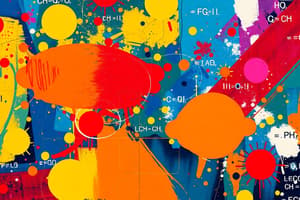Podcast
Questions and Answers
Which type of solution forms when the solute and solvent are chemically bonded, forming new substances?
Which type of solution forms when the solute and solvent are chemically bonded, forming new substances?
- Gaseous solutions
- Colloidal solutions
- True solutions (correct)
- Colligative solutions
What type of solution lowers the freezing point of water without any chemical reaction with the solvent?
What type of solution lowers the freezing point of water without any chemical reaction with the solvent?
- Colloidal solutions
- True solutions
- Gaseous solutions
- Colligative solutions (correct)
What is the fundamental concept in chemistry that describes the amount of solute in a solution?
What is the fundamental concept in chemistry that describes the amount of solute in a solution?
- Density
- Molarity (correct)
- Atomic mass
- Acidity
Which solution preparation technique involves adding more solute to a smaller volume of solvent?
Which solution preparation technique involves adding more solute to a smaller volume of solvent?
What property of a solution causes its boiling point to be higher than that of the pure solvent?
What property of a solution causes its boiling point to be higher than that of the pure solvent?
Which property results in the vapor pressure of a solution being lower than that of the pure solvent?
Which property results in the vapor pressure of a solution being lower than that of the pure solvent?
What is the formula used to solve dilution problems in chemistry solutions?
What is the formula used to solve dilution problems in chemistry solutions?
In a dilution problem, if 3 moles of solute are dissolved in 500 mL of solvent, what volume of the initial solution is needed to prepare 1 mole in 1000 mL of solvent?
In a dilution problem, if 3 moles of solute are dissolved in 500 mL of solvent, what volume of the initial solution is needed to prepare 1 mole in 1000 mL of solvent?
What is the main purpose of solving equations when dealing with solutions in chemistry?
What is the main purpose of solving equations when dealing with solutions in chemistry?
Which type of solution is uniform in composition throughout?
Which type of solution is uniform in composition throughout?
What distinguishes a homogeneous solution from a heterogeneous solution?
What distinguishes a homogeneous solution from a heterogeneous solution?
Which term refers to the quantity of solute dissolved in a given quantity of solvent or solution?
Which term refers to the quantity of solute dissolved in a given quantity of solvent or solution?
Flashcards are hidden until you start studying
Study Notes
Solving Equations and Solutions in Chemistry
Solutions are ubiquitous in chemistry, as they allow us to study and manipulate various substances in their dissolved form. Though the concept of solutions may seem straightforward, delving deeper into their aspects reveals a wealth of information. From solving equations involving concentrations to understanding the different types of solutions and their properties, let's explore this fascinating topic.
Solving Equations
When dealing with solutions, we often need to solve equations to determine the concentration of substances, the quantity of solutes, or the volume of solvents. Let's consider a simple dilution problem: If 3 moles of solute are dissolved in 500 mL of solvent, and you wish to prepare a solution with 1 mole of solute in 1000 mL of solvent, what's the volume of the initial solution you need to add?
To solve this problem, we can use the formula for dilution:
[ \frac{V_1 \cdot C_1}{V_2} = C_2 ]
where (V_1) and (V_2) are the volumes of the initial and final solutions, respectively, and (C_1) and (C_2) are their concentrations.
Substituting the given values gives us:
[ \frac{500 \text{ mL} \cdot 3 \text{ mol}}{1000 \text{ mL}} = 1 \text{ mol} ]
Solving for (V_1):
[ 150 \text{ mL} = V_1 ]
So, we need 150 mL of the initial solution.
Types of Solutions
There are two main types of solutions: homogeneous and heterogeneous. Homogeneous solutions, such as sugar dissolved in water, appear uniform throughout, while heterogeneous solutions, like sand and water, have distinct phases. More specifically, there are four types of homogeneous solutions:
- True solutions: The solute and solvent are chemically bonded, forming new substances (solutes). Examples include salt dissolved in water to form aqueous sodium chloride.
- Colligative solutions: Solutes have no chemical interaction with the solvent, but their presence changes some of the solvent's properties. Examples include dissolved iodine in water, which does not react but lowers the freezing point of water.
- Colloidal solutions: The solute and solvent particles are similar in size, creating a suspension that remains stable over time. Examples include fog, milk, and clay in water.
- Gaseous solutions: The solute and solvent are gases that dissolve in each other. Examples include air and carbon dioxide in water.
Solution Concentration
Concentration is a fundamental concept in chemistry, describing the amount of solute in a solution. Some common units for concentration are moles per liter (mol/L), grams per liter (g/L), or mass fraction. For example, a 100 g/L solution of sugar in water means that there are 100 grams of sugar in 1 liter of solution.
Solution Preparation Techniques
There are several methods used in preparing solutions, such as:
- Dilution: Adding a smaller volume of a more concentrated solution to a larger volume of solvent.
- Concentration: Adding more solute to a smaller volume of solvent.
- Mixing: Combining equal volumes of two solutions with different concentrations.
- Crystallization: Removing solvent from a saturated solution until a solid precipitate forms.
Solution Properties
Solutions exhibit unique properties, such as:
- Boiling point elevation: The boiling point of a solution is higher than the boiling point of the pure solvent due to the solute's interaction with the solvent.
- Freezing point depression: The freezing point of a solution is lower than the freezing point of the pure solvent due to the solute's interaction with the solvent.
- Vapor pressure lowering: The vapor pressure of a solution is lower than the vapor pressure of the pure solvent due to the solute's interaction with the solvent.
- Osmotic pressure: The pressure required to prevent the flow of solvent through a semi-permeable membrane separating a solution from a pure solvent.
In summary, solutions are an integral part of chemistry, and understanding their characteristics, properties, and preparation techniques is essential for tackling various problems in the field. As you delve deeper into chemistry, you'll find that solutions continually reveal their complexity and intricacy, enriching our understanding of the natural world.
Studying That Suits You
Use AI to generate personalized quizzes and flashcards to suit your learning preferences.



